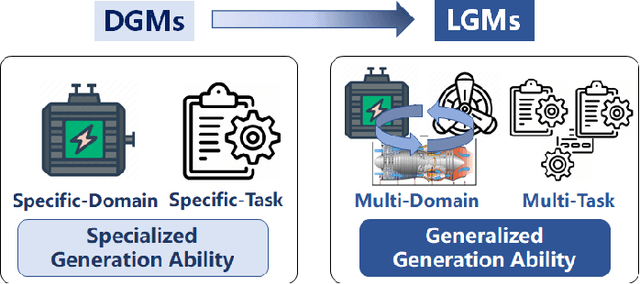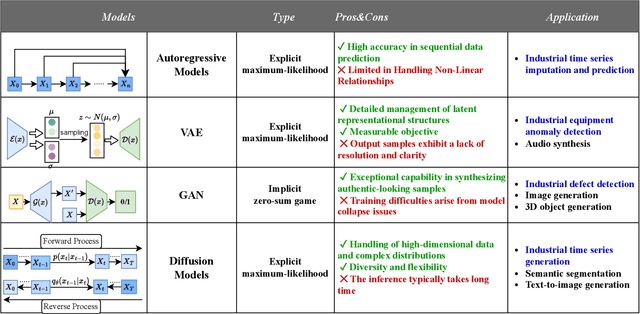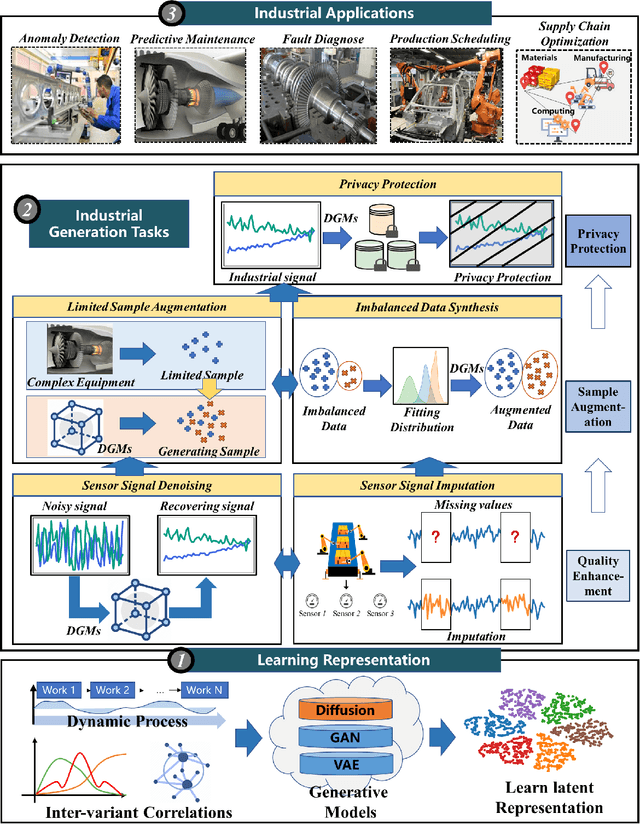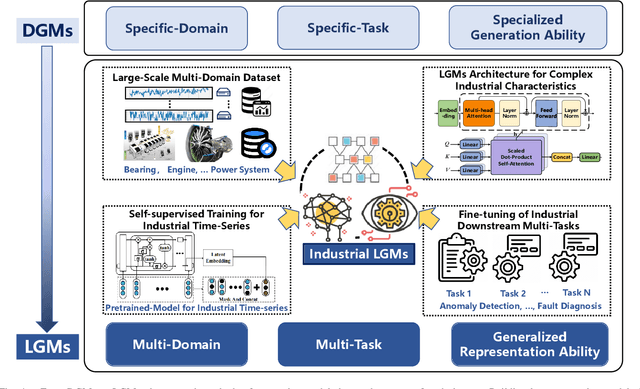Haiteng Wang
Diff-MTS: Temporal-Augmented Conditional Diffusion-based AIGC for Industrial Time Series Towards the Large Model Era
Jul 16, 2024Abstract:Industrial Multivariate Time Series (MTS) is a critical view of the industrial field for people to understand the state of machines. However, due to data collection difficulty and privacy concerns, available data for building industrial intelligence and industrial large models is far from sufficient. Therefore, industrial time series data generation is of great importance. Existing research usually applies Generative Adversarial Networks (GANs) to generate MTS. However, GANs suffer from unstable training process due to the joint training of the generator and discriminator. This paper proposes a temporal-augmented conditional adaptive diffusion model, termed Diff-MTS, for MTS generation. It aims to better handle the complex temporal dependencies and dynamics of MTS data. Specifically, a conditional Adaptive Maximum-Mean Discrepancy (Ada-MMD) method has been proposed for the controlled generation of MTS, which does not require a classifier to control the generation. It improves the condition consistency of the diffusion model. Moreover, a Temporal Decomposition Reconstruction UNet (TDR-UNet) is established to capture complex temporal patterns and further improve the quality of the synthetic time series. Comprehensive experiments on the C-MAPSS and FEMTO datasets demonstrate that the proposed Diff-MTS performs substantially better in terms of diversity, fidelity, and utility compared with GAN-based methods. These results show that Diff-MTS facilitates the generation of industrial data, contributing to intelligent maintenance and the construction of industrial large models.
AIGC for Industrial Time Series: From Deep Generative Models to Large Generative Models
Jul 16, 2024



Abstract:With the remarkable success of generative models like ChatGPT, Artificial Intelligence Generated Content (AIGC) is undergoing explosive development. Not limited to text and images, generative models can generate industrial time series data, addressing challenges such as the difficulty of data collection and data annotation. Due to their outstanding generation ability, they have been widely used in Internet of Things, metaverse, and cyber-physical-social systems to enhance the efficiency of industrial production. In this paper, we present a comprehensive overview of generative models for industrial time series from deep generative models (DGMs) to large generative models (LGMs). First, a DGM-based AIGC framework is proposed for industrial time series generation. Within this framework, we survey advanced industrial DGMs and present a multi-perspective categorization. Furthermore, we systematically analyze the critical technologies required to construct industrial LGMs from four aspects: large-scale industrial dataset, LGMs architecture for complex industrial characteristics, self-supervised training for industrial time series, and fine-tuning of industrial downstream tasks. Finally, we conclude the challenges and future directions to enable the development of generative models in industry.
Universal Sleep Decoder: Aligning awake and sleep neural representation across subjects
Sep 28, 2023Abstract:Decoding memory content from brain activity during sleep has long been a goal in neuroscience. While spontaneous reactivation of memories during sleep in rodents is known to support memory consolidation and offline learning, capturing memory replay in humans is challenging due to the absence of well-annotated sleep datasets and the substantial differences in neural patterns between wakefulness and sleep. To address these challenges, we designed a novel cognitive neuroscience experiment and collected a comprehensive, well-annotated electroencephalography (EEG) dataset from 52 subjects during both wakefulness and sleep. Leveraging this benchmark dataset, we developed the Universal Sleep Decoder (USD) to align neural representations between wakefulness and sleep across subjects. Our model achieves up to 16.6% top-1 zero-shot accuracy on unseen subjects, comparable to decoding performances using individual sleep data. Furthermore, fine-tuning USD on test subjects enhances decoding accuracy to 25.9% top-1 accuracy, a substantial improvement over the baseline chance of 6.7%. Model comparison and ablation analyses reveal that our design choices, including the use of (i) an additional contrastive objective to integrate awake and sleep neural signals and (ii) the pretrain-finetune paradigm to incorporate different subjects, significantly contribute to these performances. Collectively, our findings and methodologies represent a significant advancement in the field of sleep decoding.
 Add to Chrome
Add to Chrome Add to Firefox
Add to Firefox Add to Edge
Add to Edge